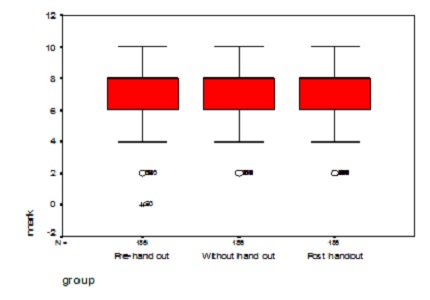The role of structured handouts in improving the teaching learning process of final year MBBS students
Abstract
Introduction: Teaching includes application of various teaching learning methods by a teacher to transfer knowledge and skills to a student. It requires a lot of effort and talents to modify the method more effectively, to communicate the ideas more easily and artistically. It is important to design tutorials and lectures according to audience perspective. Handouts for lectures have always been a much debated subject between teachers and students. This study was done to analyze whether the structured handouts enhance the learning outcomes of medical students.
Methodology: Data for the study was collected from final year MBBS students, using a Randomized controlled study design. The participants were divided randomly assigned to any of the three methods, pre handout, post handout, no handout together with traditional lecture class. Six pediatric lecture topics were taken. The three groups were assessed using post test in addition to the feedback collected from students. P- Value < 0.05 was considered as significant.
Results: Comparison of post test scores among the three groups (pre handouts, post handouts and without handouts) does not show statistical significant (p = 0.683). Even though the post test score of the ‘without handout’ group was marginally better than the ‘handout’ group, it was not statistically significant (p value= 0.557). Most of the participants are in favour of handouts. Analysis of variance test did not show any expected variation according to mode of administration. There was no significant difference in student’s performance among the three groups. Post test scores were almost similar in all the three groups (pre handouts, post handouts & no handouts).
Conclusion: Majority of the students felt that providing handouts during lectures was a better method which enhanced their understanding and scoring. But while comparing the learning outcomes of ‘handouts groups’ and ‘no handouts groups’ using post test score, it was found to be statistically not significant.
Downloads
References
2. Van Der Meer, J. Students' note-taking challenges in the twenty-first century: considerations for teachers and academic staff developers." Teaching in Higher Education 2012. 17(1): 13-23. Doi:10.1080/13562517.2011.590974.
3. Wofford MM, Spickard AW 3rd, Wofford JL. The computer-based lecture. J Gen Intern Med. 2001 Jul;16(7):464-7. [PubMed]
4. Rous BA, Rashbass JL. What can Internet technology add to pathology education? Histopathology. 2002;41(Suppl 2):216–21.
5. Mohammed Nazrul Islam, Md. Anwarul Azim Majumder, Rogayah Ja’afar, Sayeeda Rahman. Students’ Perceptions of ‘Technology-Based’ Lecture Handouts The Malaysian Journal of Medical Science 2005 Jan; 12(1): 26–28.
6. Kroenke K. Handouts: making the lecture portable. Med Teach. 1991;13(3):199-203. [PubMed]
7. Brown G, Tomlinson D. How to… Improve Handouts. Med Teach. 1980;2(5):215-20. doi: 10.3109/01421598009081192.
8. Vaz M. What do students expect of lecture handouts during the first year of the medical curriculum. Med Teacher. 1999;21:324–5.
9. Gibbs, G., S. Habeshaw and T. Habeshaw. 53 interesting things to do in your lectures 4th ed. Bristol: Technical & Educational Services, 1992.
10. Farnaz Zahedi Avval1, Lida Jarahi , Kiarash Ghazvini, and Masoud Youssefi International Journal of Education and Research 2013. Vol. 1 No. 12).
11. Michael Seery, Do you use lecture handouts, and when? cognitive load theory, lecture handouts. 2013 (http://michaelseery.com/home/index.php/2013/10/do-you-use-lecture-handouts-and-when/)
12. Piolat, A., T. Olive. Cognitive effort during note taking." Applied Cognitive Psychology. 2005. 19(3): 291-312.
13. Trickett, S. B. and J. G. Trafton. Note-taking as a strategy for learning. Proceedings of the Twenty First Annual Conference of the Cognitive Science Society: 1999. 742-748.
14. Bohay M, Blakely DP, Tamplin AK, Radvansky GA. Note taking, review, memory, and comprehension. Am J Psychol. 2011 Spring;124(1):63-73. [PubMed]
15. Russell, I. J., Caris, T. N. Effects of three types of lecture notes on medical student achievement." J Med Educ. 1983. 58(8): 627-636. journals.sagepub.com/doi/abs/10.1177/0265532211415379
16. Katayama A. D., Robinson D. H. Getting students "partially" involved in note-taking using graphic organizers." Journal of Experimental Education. 2000;68(2): 119- 133.
17. Tara L. Cornelius and Jamie Owen-DeSchryver. Differential effects of full and partial notes on learning outcomes and attendance." Teaching of Psychology. 2008. 35(1): 6-12. DOI: 10.1080/00986280701818466
18. Austin, J. L., Lee, M. G., Thibeault, M. D., Carr, J. E., & Bailey, J. S. Effects of guided notes on university students’ responding and recall of information. Journal of Behavioral Education, 2002;11, 243–254.
19. Annis, L. F. Effect of preference for assigned lecture notes on student achievement. Journal of Educational Research, 1981;74, 179–182. http://dx.doi.org/10.1080/00220671.1981.10885306.

Copyright (c) 2017 Author (s). Published by Siddharth Health Research and Social Welfare Society

This work is licensed under a Creative Commons Attribution 4.0 International License.


 OAI - Open Archives Initiative
OAI - Open Archives Initiative


